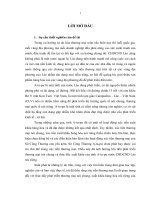scleromyxedema arndt gottron syndrome a case report
Bạn đang xem bản rút gọn của tài liệu. Xem và tải ngay bản đầy đủ của tài liệu tại đây (646.32 KB, 11 trang )
D. Popović et al.
Scleromyxedema (Arndt-Gottron Syndrome)
Serbian Journal of Dermatology and Venereology 2016; 8 (1): 28-38
DOI: 10.1515/sjdv-2016-0003
Scleromyxedema (Arndt-Gottron Syndrome): a Case Report
Danijela POPOVIĆ*, Mirjana PARAVINA, Dragan JOVANOVIĆ, Vesna KARANIKOLIĆ,
Dragana LJUBISAVLJEVIĆ
Clinic of Skin and Venereal Disease, Clinical Center Niš, Serbia
Medical Faculty, University of Niš, Serbia
*Correspondence: Danijela Popović, e-mail:
UDK 616.5-004
Abstract
Lichen myxedematosus, also known as papular mucinosis, is a primary diffuse cutaneous mucinosis. It is a rare
cutaneous myxedematous condition characterized by formation of numerous lichenoid papules. Scleromyxedema,
also known as Arndt–Gottron syndrome, is a rare, confluent, papular and sclerotic variant of lichen myxedematosus,
characterized by diffuse thickening of the skin underlying the papules. The condition is associated with systemic, even
lethal manifestations, fibroblast proliferation and accumulation of acid mucopolysaccharides of the hyaluronic acid.
Serum IgG class paraproteinemia is always present and it can be detected in all patients if appropriate or even repeat
testing is used.
Herein, we present a 67-year-old patient with a 2-year history of skin problems. He had no health problems other
than hypertension and diabetes, wich were both diagnosed 15 years before. On examination, the patient exhibited
sclerodermoid lesions with diffuse pseudo-sclerodermatous thickening of the exposed skin, microstomia and
sclerodactyly-like changes; on the face, there were numerous solid, shiny 2 - 4 mm in diameter skin-coloured lichenoid
papules, scattered across the forehead, glabellar area, nasolabial folds, perioral region, ear lobes and the neck.
Histopathological examination revealed: highly distinctive collagenosis and fibrosis in the middle dermis, increased
fibroblasts; collagen bundles with irregular arrangement and fragmentation; alcian blue-positive deposits with
appearance consistent with acid mucins. Serum protein electrophoresis detected IgG lambda paraproteinemia. The
patient was treated with systematic corticosteroids during 9 months with subsequent introduction of methotrexate and
showed satisfactory results.
The etiology of scleromyxedema remains unknown, since the purified IgG paraprotein itself has no direct effects on
fibroblast proliferation. In scleromyxedema, numerous therapeutic modalities are proposed, unfortunatelly with limited
effects.
In colclusion, we report a case of an adult male with lichenoid papules; after a two-year progression, they evolved into
scleromyxedema and exhibited well response to conventional therapy.
Key words
Scleromyxedema; Skin Diseases; Diagnosis; Therapeutics; Case Reports; Treatment Outcome
L
ichen myxedematosus, also known as papular
mucinosis, is a primary diffuse cutaneous
mucinosis. It is a rare cutaneous myxedematous
condition characterized by formation of numerous
lichenoid papules. Scleromyxedema, or Arndt–
Gottron syndrome, is a rare, confluent, papular
and sclerotic variant of lichen myxedematosus,
which is characterized by diffuse thickening of the
skin that underlies the papules. The condition is
28
associated with systemic, even lethal manifestations,
fibroblast proliferation and accumulation of acid
mucopolysaccharides of the hyaluronic acid. Serum
IgG class paraproteinemia is always present and it can
be detected in all patients after appropriate or repeat
testing (1, 2, 3).
A case of an adult male with IgG paraproteinemia,
in whom lichenoid papules evolved to scleromyxedema
after two years, is reported.
© 2016 The Serbian Association of Dermatovenereologists
Unauthenticated
Download Date | 1/16/17 3:13 AM
CASE REPORT
Serbian Journal of Dermatology and Venereology 2016; 8 (1): 28-38
Case Report
A 67-year-old patient was referred with a 2-yearlong history of skin lesions that initially started on
the forehead and earlobes, and then subsequently
spread to the trunk and extremities. The patient was
previously treated as an out-patient with the following
diagnoses: steatocystoma multiplex< xanthelasma<
erythroderma. He had no health problems other than
hypertension and diabetes mellitus, wich were both
diagnosed 15 years before.
On admission, the patient exhibited sclerodermoid lesions, with diffuse pseudosclerodermatous
thickening of the exposed skin, microstomia and
Figure 2. Diffuse thickening of the skin of the hands
sclerodactyly-like changes (Figures 1, 2, 3), as well as
elephatiasis thickening on the trunk and extremities
(Figures 4, 5, 6, 7) There were numerous lichenoid,
solid, hemispherical, shiny, skin-coloured papules
2 - 4 mm in diameter, scattered across the forehead,
glabellar area, nasolabial folds, perioral region, ear
lobes, with linear distribution on the neck (Figures 8,
9, 10).
Laboratory test results
Laboratory tests revealed the following abnormal test
results: elevaed erythrocyte sedimentation rate - 19,
C-reactive protein - 15,5 mg/L (normal range 0 - 5
mg/L), fibrinogen - 6,1 g/L (normal range 1,86 3,86 g/l), glucose - 9,2 mmol/L, (normal range 3,9
- 6,1 mmol/l), glycated hemoglobin (HbA1c) level 9,30% (normal range 4.8 - 5.9), b2 microglobulin 3,27 (normal range 0,97 - 2,64 mg/l). Serum protein
electrophoresis revealed “M spike” present in the
lambda fraction, and immunofixation showed IgG
lambda paraprotein; urinalysis for free light chains
(Bence-Jones proteins) was negative. All other findings
were within normal limits including the following:
baseline laboratory tests such as complete blood count,
Figure 1. Persistent skin induration on the face,
forehead, nasolabial area, and chin with microstomy
Figure 3. Diffuse hyperpigmentation and induration
of the skin of the legs
29
© 2016 The Serbian Association of Dermatovenereologists
Unauthenticated
Download Date | 1/16/17 3:13 AM
Serbian Journal of Dermatology and Venereology 2016; 8 (1): 28-38
D. Popović et al.
Scleromyxedema (Arndt-Gottron Syndrome)
Figure 4. Elephantiasis thickening of the skin of the
trunk
Figure 5. Skin thickening on the trunk with coarse
folds
serum electrolytes, blood urea nitrogen and creatinine,
aspartate aminotransferase, alanine aminotransferase,
gamma-glutamyl transpeptidase, amylase, lipase,
creatine phosphokinase, lactate dehydrogenase, alkaline
phosphatase, rheumatoid factor, antistreptolysin titer,
lipid status, ferritin, thyroid hormones - thyroxine,
triiodothyronine and pituitary thyroid stimulating
hormone, as well as antinuclear antibodies, antibodies
to double-stranded DNA (dsDNA), antibodies to
Sjogren’s Syndrome related antigen A (anti-Ro/SSA), antibodies to Sjogren’s Syndrome related antigen
B (anti-SS-B/La), antibodies to topoisomerase (antiScl-70), anticentromere and anticardiolipin antibodies.
Histopathological analysis
Histopathological analysis of skin biopsy specimens
showed: profound epidermolytic hyperkeratosis in
the epidermis; discrete lymphocytic perivascular
infiltrate in the upper dermis, flattening of the
epidermal dermal junction, atrophy of the adnexal
structures; highly distinctive collagenosis and fibrosis;
increased fibroblasts; collagen bundles exhibiting
irregular arrangement and fragmentation; alcian bluepositive deposits in reticular dermis, with appearance
consistent with acid mucins (Figure 11).
Histopathological analysis of bone marrow
biopsy specimens was normal.
30
© 2016 The Serbian Association of Dermatovenereologists
Unauthenticated
Download Date | 1/16/17 3:13 AM
CASE REPORT
Figure 6. Numerous lichenoid papules on the arms
Nailfold capillaroscopy
Nailfold capillaroscopy showed a significant decrease in the
number of capillaries, which were fragile and irregularly
distributed but without markedly dilated capillary loops.
Radiography
Chest and esophageal passage x-ray (including barium
swallow) were normal.
Bone redaiographs of the hands revealed
osteodegenerative changes with narrowing of the distal
interphalangeal spaces.
Ultrasonography
Ultrasound of the upper abdomen revealed a cyst, 10
mm in diameter, in the right kidney.
Serbian Journal of Dermatology and Venereology 2016; 8 (1): 28-38
Figure 7. Diffuse hyperpigmentation and induration
of the skin of the legs
Specialist consultations
Specialist consultations established the diagnosis of
insulin-dependent diabetes, therefore insulin therapy
was indicated.
Therapy
Apart from insulin, systemic methylpred-nisolone was
initiated parenterally at a dose of 60 mg daily,
with gradual dose reduction and conversion to
oral therapy. Two months later, the clinical status
showed considerable improvement: the number
of lichenoid papules on the face (Figure 12) and
on the neck was reduced; elephantiasic skin folds
and hyperpigmentation dramatically decreased,
especially on the trunk and extremities (Figures 13,
31
© 2016 The Serbian Association of Dermatovenereologists
Unauthenticated
Download Date | 1/16/17 3:13 AM
D. Popović et al.
Scleromyxedema (Arndt-Gottron Syndrome)
Serbian Journal of Dermatology and Venereology 2016; 8 (1): 28-38
Figure 8. Numerous lichenoid papules - especially
on the forehead and in the glabellar region
14). The most resistant to therapy were nasolabial
folds, earlobes and hands, where induration, papules
and sclerodermoid appearance were still present, but
with a subjective feeling of better mobility of fingers.
After being dismissed from the hospital, the patient
was treated with prednisone tablets - 30 mg per day.
Six months later, due to persistent skin induration of
the face, cheeks, chin and microstomy, the dose was
increased to 40 mg per day and methotrexate was
introduced at a weekly dose of 12,5 mg as an adjunct
therapy, which resulted in marked improvement once
again.
32
Figure 9. Solitary, hemispherical, solid papules on
the earlobes
Discussion
Scleromyxedema (papular mucinosis, lichen myxedematosus, lichen fibromucinodosis, lichen myxedematosus generalisatus et sclerodermoides, Arndt
Gottron) is a variant of cutaneous mucinosis (1, 2).
The original description of cutaneous mucinosis was
given by Dubreuilh in 1906 and Reitmann in 1908
(4, 5).
All cutaneous mucinoses are divided into primary
and secondary. Primary mucinoses can be subdivided
into diffuse degenerative inflammatory mucinoses,
focal hamartomatous neoplastic mucinoses and
© 2016 The Serbian Association of Dermatovenereologists
Unauthenticated
Download Date | 1/16/17 3:13 AM
CASE REPORT
Figure 10. Linear papules on the neck
follicular mucinoses. The group of degenerative
inflammatory mucinoses comprises several different
conditions, such as generalized and several localized
forms of lichen myxedematosus (LM) (1).
In 1953, Montgomery and Underwood
distinguished 4 types of LM: 1) generalized lichenoid
eruption, later called scleromyxedema; 2) discrete
papular form; 3) generalized or localized lichenoid
plaque form; and 4) urticarial plaque form (6). The
term ”scleromyxedema” was coined by Gottron in 1954
to signify the generalized lichenoid papular eruption
with sclerodermoid appearance (7). In the literature,
terms LM, papular mucinosis, and scleromyxedema
have been often used indiscriminately as synonyms,
but in 2001 based on personal experience and literature
review, Rongioletti concluded that most reported
cases of LM or papular mucinosis published without
indication of the subtype, appeared in fact to be cases
of scleromyxedema. He also recognized two clinicopathological subsets of LM, a generalized papular and a
sclerodermoid form (also called scleromyxedema) with
Serbian Journal of Dermatology and Venereology 2016; 8 (1): 28-38
systemic, even lethal, manifestations, and a localized
papular, more benign form, without a demonstrable
paraprotein, with 5 subtypes: 1) a discrete papular
form involving any site; 2) acral persistent papular
mucinosis involving only the extensor surface of the
hands and wrists; 3) self-healing papular mucinosis,
of a juvenile and adult type; 4) papular mucinosis of
infancy, a pediatric variant of the discrete form or of
acral persistent papular mucinosis; and 5) nodular
form (8).
Scleromyxedema is a rare chronic cutaneous
myxedematous condition of the connective tissue (1,
9, 10) which occurs in middle-aged individuals (11),
most commonly between the ages of 30 and 80, in
all ethnic groups and equally in both sexes (10, 11).
The etiopathogenesis of scleromyxedema hasn’t been
fully clarified. There is hyperproliferation of dermal
fibroblasts which produces mucin in quantities
larger than normal fibroblasts, with increased
collagen deposition (3). The serum shows the ability
to stimulate fibroblast proliferation in vitro, thus
indicating the role of monoclonal paraproteinemia.
The presence of monoclonal component (M
component) or paraprotein in sera of patients with
lichen myxoedematosus and scleromyxedema has
been noted in nearly all cases. However, this ability
of the serum remains even after the removal of IgG,
which indicates that in addition to paraproteinemia,
another circulatory factor is responsible. Thus,
the role of serum paraproteins in scleromyxedema
pathogenesis remains unknown (1, 2, 3, 12). It has
been suggested that innate altered regulation of dermal
fibroblast growth might play a role in pathogenesis of
sclermyxedema (3). Paraproteinemia, or monoclonal
gammopathy, delineates an immunoproliferative
disorder manifested by the presence of excessive
amounts of one monoclonal gamma globulin in
blood. There are three types of paraproteins: light
chain, heavy chain, and whole immunoglobulin, each
of them can be present alone, or combined. Light
chains can be excreted through urine, and then they
are called Bence-Jones proteins. Potential causes of
paraproteinemia include the following: leukemia
and lymphatic myeloma (in 8.7% of the cases it is
combined with multiple myeloma), plasmacytoma,
or it is manifested as in our patient idiopathically as
monoclonal gammopathy of unspecified cause. As far
33
© 2016 The Serbian Association of Dermatovenereologists
Unauthenticated
Download Date | 1/16/17 3:13 AM
Serbian Journal of Dermatology and Venereology 2016; 8 (1): 28-38
D. Popović et al.
Scleromyxedema (Arndt-Gottron Syndrome)
Figure 11. Histopathological analysis of the skin biopsy specimens showed: highly distinctive collagenosis and
fibrosis, as well as an increased number of fibroblasts; irregular arrangement and fragmentation of collagen
bundles (HE stain, x 100)
as scleromyxedema is concerned, the serum protein
electrophoresis most frequently detects a monoclonal
type IgG paraprotein of lambda light chain isotype,
while IgA and IgM proteins are less common.
Paraprotein IgG lambda, also present in our patient,
has a molar eght of 110.000 daltons, whereas normal
IgG weighs 160.000 daltons. These findings suggest
that paraprotein IgG is an incomplete IgG molecule
which lost a significant antigen part of Fc fragment.
The IgG of lichen myxedematosus differes from the
IgG of multiple myeloma not only by usually showing
slower electrophoretic migration, but also by the fact
that its IgG molecules nearly always possess light
chains of the lambda type. The role of the monoclonal
IgG in lichen myxedematosus is not clear. Although
the serum from patients with lichen myxedematosus
stimulates fibroblast proliferation in vitro, the purified
IgG paraprotein itself has no direct effects on fibroblast
proliferation (3).
Scleromyxedema, a generalized papular form of
LM is characterized by the presence of the following
criteria (13): 1) multiple cutaneous manifestations
(papules, nodules, plaques) and sclerodermiform
diffuse thickening of the skin of the elephantiasis
type; 2) specific histologic findings, including mucin
34
deposits, fibrosis and fibroblast proliferation; 3)
monoclonal paraproteinemia; 4) absence of thyroid
disease; 5) potential systematic spreading, sometimes
with lethal outcome. In scleromyxedema, these
characteristics represent crucial criteria in diagnosing
the generalized disease (1). However, in order to
diagnose localized LM, the presence of the first and
second of the aformentioned characteristics is required,
as well as the absence of the third, fourth, and the fifth
one. Our patient met 4 of 5 aforementioned criteria:
skin lesions, specific histologic findings, monoclonal
paraproteinemia and absence of thyroid disease.
There is a triad of histopathologic characteristics
of scleromyxedema (8, 3): 1) diffuse mucin deposition
in the upper and mid reticular dermis; 2) increase
collagen deposition, 3) significant proliferation of
irregularly distributed fibroblasts. The epidermis may
be normal or thickened due to mucin pressure and
fibrosis, hair follicles may be atrophic, as in our patient;
slight, perivascular, superficial lymphoplasmacytic
infiltrate is often present, as it was in our patient; the
elastic fibers are fragmented and decreased in number;
in systematic spreading of the disease, mucin may fill
the walls of myocardial blood vessels, as well as the
interstitium of kidney, pancreas, adrenal glands and
© 2016 The Serbian Association of Dermatovenereologists
Unauthenticated
Download Date | 1/16/17 3:13 AM
CASE REPORT
Serbian Journal of Dermatology and Venereology 2016; 8 (1): 28-38
Figure 12. Reduced papular lesions on the skin of
the face after 2 months of therapy
nerves (2). The mucin present in mucinous stains:
light blue in sections stained with hematoxylineosin; alcian blue at 2.5 ph but negative at 0.5 pH
and shows metachromasia with toluidine blue at 7.0
pH and 4.0 pH but no metachromasia below 2.0
pH< it is PAS negative, indicating absence of neutral
mucopolysacharides, and aldehyde-fuchsin negative
(indicating absence of sulfated mucopolysacharides).
Regular demonstration of the presence of mucin in the
dermis is possible only in pretibial myxedema, in self
healing-juvenile cutaneous mucinosis and in lichen
myxedematosus (3). There were alcian blue positivedeposits detected in the lesions of our patient.
Our patient presented without a thyroid disease,
but he had diabetes mellitus and hypertension.
Although no endocrine abnormalities have been
found, there are numerous extracutaneous manifestations that can be present in patients with
Figure 13. A dramatic improvement of skin lesions
over the trunk after 2 months of treatment
scleromyxedema, eg. hematological alterations such as
eosinophilia, neurological manifestations (confusion,
dysarthria, ascending paralysis, convulsions and
coma; combination of high temperature, convulsions
and coma), proximal myopathy, inflammatory
polyarthritis, laryngeal alterations, esophageal
dysfunction, pulmonary restrictive disease, and in
10% cardial alterations (1). Occasionally, systemic
involvement may occur in other internal organs. There
are reports of hepatitis C virus infection (9), bilateral
scleromyxedema of the eyelids (14), and dermatoneuro syndrome (10); malignant hematological
neoplasia (multiple myeloma, acute leukemia and
35
© 2016 The Serbian Association of Dermatovenereologists
Unauthenticated
Download Date | 1/16/17 3:13 AM
D. Popović et al.
Scleromyxedema (Arndt-Gottron Syndrome)
Serbian Journal of Dermatology and Venereology 2016; 8 (1): 28-38
T-cell lymphoma) as well as cancers, including thymic
carcinoma (15).
Scleromyxedema can be clinically differentiated
from scleroderma by the presence of papules and the
absence of telangiectasias: scleromyxedema, presents
with generalized eruption of papules as in lichen
myxedematosus and diffuse erythematous tickening
of the skin which is movable over the subcutis, not
bound down as in scleroderma (1, 3).
No established standard therapy exists for
systemic treatment of scleromyxedema. Various
medications and methods are used with varying,
mostly insufficient therapeutic effects (11). These
include: topical application and intralesional injection
of hyaluronidases, topical, intralesional and systemic
administration of corticosteroids, radiotherapy,
psoralen and ultraviolet A (PUVA) phototherapy,
plasmapheresis combined with pulsed corticosteroid
and/or immunosuppressive therapy, intravenous
immunoglobulin combined with thalidomide,
extracorporeal photochemotherapy (12, 16, 17, 18),
retinoids (11), peripheral blood autologous stem cell
transplantation (16). Aggressive surgical interventions
may be indicated for palliative care, esthetic corrections,
and functional training. Melphalan, as a cytoreduction
chemotherapeutic agent, has been considered as the
first line therapy for decades (16, 18). Our patient was
treated with systemic corticosteroids continuously
during 9 months, with subsequent introduction of
methotrexate. Satsifactory results have been achieved,
which was also reported by other authors (19).
The disease has a chronic progressive course.
Spontaneous improvement is possible, but extremely
rare. The possibility of other organs being affected must
also be taken into consideration (11). The prognosis is
rather poor. Lethal outcome is also possible as a result
of non-specific complications, but also hematological
malignancy (1). Clinical staging of scleromyxedema
has been proposed as follows: 1) limited cutaneous
papular mucinosis; 2) generalized cutaneous mucinosis
and/or extracutaneous manifestations; 3) generalized
cutaneous
mucinosis
and/or
extracutaneous
manifestations with a Karnofsky performance status
less than 50% (20, 21). The Karnofsky Performance
Status (KPS) is a widely used method to assess the
functional status of patients.
Full staging investigations should always be
36
undertaken before making any decisions concerning
the treatment strategy. Our patient presented with the
first limited cutaneous stage of the disease.
Conclusion
We reported a case of an adult male in whom
lichenoid papules of lichen myxedematosus evolved
into scleromyxedema after a two-year pregression with
no extracutaneous manifestations, and good response
to conventional therapy.
Abbreviations
LM - lichen myxedematosus
HbA1c - glycated hemoglobin A1c
ds DNA - double stranded deoxyribonucleic acid
Ro/SS-A - Sjogren’s Syndrome-related antigen A
SS-B/La - Sjogren’s Syndrome-related antigen B
Scl-70 - topoisomerase 1
KPS - Karnofsky performance status
References
1. Breathnach SM. Mucinoses. In: Burns DA, Breathnach SM,
Cox NH, Griffiths CEM, editors. Rook`s textbook of dermatology. 8th edition. Oxford: Blackwell Publishing Ltd; 2010.
p. 59.21-59.30.
2. Rongioletti F, Rebora A. Mucinosis. In: Bolognia JL, Jorizzo JL,
Rapini RP, editors. Dermatology. 2nd edition. London: Mosby
Elsevier; 2008. p. 611-21.
3. Maize J, Maize J Jr, Metcalf J. Metabolic diseases of the skin.
In: Elder DE, Elenitsas R, Johnson BL Jr, Murphy GF, editors.
Lever’s histopathology of the skin. 9th ed. Philadelphia:
Lippincott Williams & Wilkins; 2005. p. 435-67.
4. Dubreuilh W. Fibromes miliares folliculaires: sclerodermie
consecutive. Arch Dermatol Syph 1906;37:569-72.
5. Reitmann K. Uber eine eigenartige, der sklerodermie
nahestehende affection. Arch Dermatol Syph 1908;92:417-24.
6. Montgomery H, Underwood LJ. Lichen myxedematosus
(diferentiation from cutaneous myxedemas or mucoid states).
J Invest Dermatol 1953;20(3):213-36.
7. Gottron HA. Skleromyxödem; eine eigenartige Erscheinungsform von Myxothesaurodermie. Arch Klin Exp Dermatol
1954;199(1):71-91.
8. Rongioletti F, Rebora AN. Updated classification of papular
mucinosis, lichen myxedematosus, and scleromyxedema. J Am
Acad Dermatol 2001;44(2):273-81.
9. Azfar NA, Khan AR, Zaman T, Jahangir M. Scleromyxedema
in an HCV- positive male. Journal of Pakistan Association of
Dermatologists 2008;18:116-8.
10. Savran Y, Akarsu S. Dermato-neuro syndrome in a case of
scleromyxedema. Eur J Rheumatol 2015; DOI:10.5152/
eurjrheum.2015.0116.
11. Serdar ZA, Altunay IK, Yasar SP, Erfan GT, Gunes P. Generalized
papular and sclerodermoid eruption: scleromyxedema. Indian
© 2016 The Serbian Association of Dermatovenereologists
Unauthenticated
Download Date | 1/16/17 3:13 AM
CASE REPORT
J Dermatol Venereol Leprol 2010;76(5):592.
12. Weening RH, Pittelkow MR. Scleredema and scleromyxedema.
In: Wolff K, Goldsmith L, Katz S, Gilchrest B, Leffell D, Paller
A, editors. Fitzpatrick`s dermatology in general medicine. 7th
edition. New York: Mc Graw Hill Medical; 2008. p. 1562-6.
13. Salas-Alanis JC, Martinez-Jaramillo B, Gomez-Flores M, OcampoCandiani J. Scleromyxedema, a therapeutic dilemma. Indian J
Dermatol 2015;60(2):215.
14. Shams M, Javadi MA, Bidaki R. Bilateral scleromyxedema of
eyelids: a rare report in psychodermo-ophthalmology: clinical
image. JSM Ophthalmol 2015;3(2):1030.
15. Chan JC, Trendell-Smith NJ, Yeung CK. Scleromyxedema:
a Cutaneous Paraneoplastic Syndrome associated with thymic
carcinoma. J Clinical Oncol 2012;30(3):e27-9.
16. Laimer M, Namberger K, Massone C, Koller J, Emberger
M, Pleyer L, et al. Vincristine, idarubicin, dexamethasone
and thalidomide in scleromyxoedema. Acta Derm Venereol
2009;89(6):631-5.
Serbian Journal of Dermatology and Venereology 2016; 8 (1): 28-38
17. Efthimiou P, Blanco M. Intravenous gammaglobulin and thalidomide may be an effective therapeutic combination in refractory
scleromyxedema: case report and discussion of the literature. Semin
Arthritis Rheum 2008;38(3):188-94.
18. Meigel W. Mucinoses. In: Burgdorf WH, Plewig G, Wolf
HH, Landthaler M, editors. Braun-Falco`s dermatology. 3th
ed. Munich: Springer; 2009. p. 1263-73.
19. Mehta V, Balachandran C, Rao R. Arndt Gottron scleromyxedema: successful response to treatment with steroid minipulse
and methotrexate. Indian J Dermatol 2009;54(2):193-5.
20. Donato ML, Feasel AM, Weber DM, Prieto VG, Giralt
SA, Champlin RE, et al. Scleromyxedema: role of high-dose
melphalan with autologous stem cell transplantation. Blood
2006;107(2):463–6.
21. Péus D, Newcomb N, Hofer S. Appraisal of the Karnofsky
Performance Status and proposal of a simple algorithmic
system for its evaluation. BMC Med Inform Decis Mak
2013;13:72.
Skleromiksedem (Arndt−Gottron syndrome) − prikaz slučaja
Sažetak
Uvod.
Miksedematozni
lihen
(lat.
lichen
myxoedematosus) takođe poznat pod nazivom papulozna
mucinoza, klasifikovan je kao primarna kutana difuzna
mucinoza. Predstavlja retko miksedematozno stanje u
koži koje karakteriše formiranje brojnih lihenoidnih
papula. Skeromiksedem, poznat i kao Arnt−Gotronov
(Arndt-Gottron) sindrom, retka je papulozna
sklerodermiformna varijanta miksedematoznog lihena,
u kojoj aglomerirane papule rezultuju difuznim
zadebljanjem kože. Stanje je povezano sa sistemskim,
čak i letalnim, manifestacijama, tako da se razlikuju
tri stadijuma skleromiksedema: 1) limitirana,
kutana papulozna mucinoza; 2) generalizovana
kutana mucinoza i/ili ekstrakutane manifestacije; 3)
generalizovana kutana mucinoza i/ili ekstrakutane
manifestacije uz Karnofski status manji od 50%.
U osnovi patogenetskog mehanizma skleromiksedema
je proliferacija fibroblasta i akumulacija kiselih
mukopolisaharida
tipa
hijaluronske
kiseline.
Paraproteinemija IgG klase je prisutna u serumu i može
biti detektovana kod svih pacijenata ukoliko se sprovodi
na adekvatan način, ponekad u više ponovljenih
pokušaja.
Dijagnoza bolesti se postavlja na osnovu kliničke
slike, histopatološkog nalaza depozita kiselih mucina
u retikularnom dermisu, proliferisalih fibroblasta i
fragmenacije umnoženih kolagena vlakna, uz prisustvo
u serumu monoklonalne gamapatije. U diferencijalnoj
dijagnozi potrebno je razlikovati sklerodermiju, u kojoj
nema papula, a zadebljala koža nije čvrsto srasla za
potkožno masno tkivo.
Prikaz slučaja. Prikazujemo pacijenta starosti 67 godina,
sa dvogodišnjom evolucijom promena na koži. Pacijent
nije imao drugih zdravstvenih tegoba osim hipertenzije
i dijabetesa melitus, koji su dijagnostikovani 15 godina
ranije.
Tokom ispitivanja, pacijentova koža je imala
sklerodermoidni izgled sa difuznim pseudosklerodermatskim zadebljanjem, ”mikrostomijom” i
promenama sličnim sklerodaktiliji; na licu, u predelu
glabele na čelu, nazolabijalnim brazdama, perioralnoj
regiji, ušnim školjkama i vratu, bio je prisutan veliki broj
sjajnih, uniformnih, 2−4 mm u dijametru lihenoidnih
papula, normalne boje kože.
U isečku ledirane kože, histopatološkom analizom
otkrivene su sledeće promene: kolagenoza i fibroza
u retikularnom dermisu; između kolagenih vlakana
povećan broj fibroblasta; nepravilan raspored i
fragmentacija kolagena usled alcijan plavo-pozitivnih
depozita koji bi mogli odgovarati kiselom mucinu.
Elektroforezom serumskih proteina detektovana je IgG
lambda paraproteinemija.
Pacijent je lečen sistemskim kortikosteroidima tokom
9 meseci; uveden je i metotreksat, što je dovelo do
37
© 2016 The Serbian Association of Dermatovenereologists
Unauthenticated
Download Date | 1/16/17 3:13 AM
Serbian Journal of Dermatology and Venereology 2016; 8 (1): 28-38
privremene ali ne i trajne remisije.
Diskusija. Etiologija skleromiksedema ostaje nepoznata
pošto za razliku od seruma obolelih, prečišćen IgG
paraprotein samostalno nema direktni efekat na
proliferaciju fibroblasta.
I pored brojnih terapijskih modaliteta, prognoza
oboljenja je loša, a prisustvo paraproteina uvek može
D. Popović et al.
Scleromyxedema (Arndt-Gottron Syndrome)
značiti uvod u malignu hemopatiju.
Zaključak. U radu je prikazan slučaj odrasle muške
osobe, kod koje su lihenoidne papule nakon
dvogodišnje progresije evoluirale u generalizovane,
difuzne sklerodermoidne lezije skleromiksedema, bez
zahvatanja drugih organa, sa dobrim odgovorom na
primenjenu kovencijalnu terapiju.
Ključne reči
Skleromiksedem; Kožne bolesti; Dijanoza; Terapija; Prikazi slučajeva; Ishod terapije
38
© 2016 The Serbian Association of Dermatovenereologists
Unauthenticated
Download Date | 1/16/17 3:13 AM








